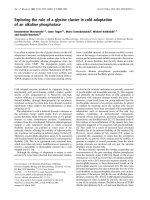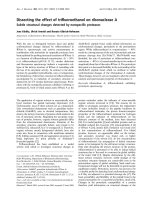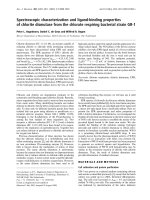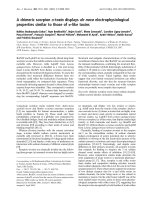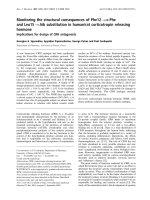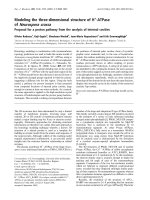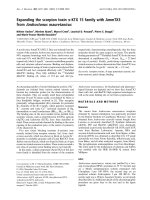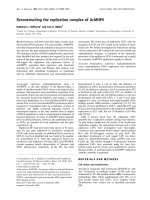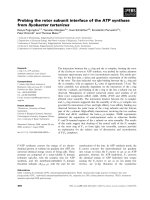Báo cáo Y học: Expanding the scorpion toxin a-KTX 15 family with AmmTX3 from Androctonus mauretanicus pptx
Bạn đang xem bản rút gọn của tài liệu. Xem và tải ngay bản đầy đủ của tài liệu tại đây (202.38 KB, 5 trang )
Expanding the scorpion toxin a-KTX 15 family with AmmTX3
from
Androctonus mauretanicus
He
´
le
`
ne Vacher
1
, Meriem Alami
3
, Marcel Crest
2
, Lourival D. Possani
4
, Pierre E. Bougis
1
and Marie-France Martin-Eauclaire
1
1
UMR 6560 CNRS and
2
UMR 6150 CNRS, Universite
´
de la Me
´
diterrane
´
e, Faculte
´
de Me
´
decine secteur Nord, IFR Jean Roche,
Marseille, France;
3
Institut Pasteur du Maroc, Casablanca, Morocco;
4
Biotechnology Institute, UNAM, Cuernavaca, Mexico
A novel toxin, AmmTX3 (3823.5 Da), was isolated from the
venom of the scorpion Androctonus mauretanicus. It showed
94% sequence homology with Aa1 from Androctonus aus-
tralis and 91% with BmTX3 from Buthus martensi which,
respectively, blockA-type K
+
current incerebellum granular
cells and striatum cultured neurons. Binding and displace-
ment experiments using rat brain synaptosomes showed that
AmmTX3 and Aa1 competed effectively with
125
I-labelled
sBmTX3 binding. They fully inhibited the
125
I-labelled
sBmTX3 binding (K
i
values of 19.5 p
M
and 44.2 p
M
,
respectively), demonstrating unambiguously that the three
molecules shared the same target in rat brain. The specific
binding parameters of
125
I-labelled AmmTX3 for its site were
determined at equilibrium (K
d
¼ 66 p
M
, B
max
¼ 22 fmol
per mg of protein). Finally, patch-clamp experiments on
striatal neurons in culture demonstrated that AmmTX3 was
able to inhibit the A-type K
+
current (K
i
¼ 131 n
M
).
Keywords: scorpion toxins; A-type potassium current; stri-
atum neurons; patch clamp; binding.
An increasing number of toxins blocking the activity of K
+
channels are isolated from various animal venoms and
become key molecular probes for the characterization of
these channels. They are usually small basic polypeptides
(between 30 and 70 amino acids), cross-linked by three or
four disulphide bridges, reviewed in [1]. They recognize
principally voltage-dependent (Kv) channels (in particular
Kv channels of the Kv1 family, which generate sustained
K
+
current) and some Ca
2+
-activated channels of big,
intermediate or small conductance (BK
Ca
,IK
Ca
or SK
Ca
).
The binding sites of the most studied toxins purified from
scorpion venoms, such as charybdotoxin (ChTX), agitoxin
(AgTX)andkaliotoxin(KTX),havebeendescribedin
detail. These toxins occlude channels by binding to the outer
opening of the conduction pore, at the centre of symmetry
of the channel [2–6].
Two new toxins blocking transient A-currents were
recently isolated from scorpion venoms: Aa1, from Andr-
octonus australis, which was shown to block an A-type K
+
channels in cerebellar granular cells [7] and BmTX3, from
Buthus martensi Karch, which was found to block an A-type
current in striatal neurons in culture. These toxins revealed a
new class of scorpion toxin binding sites in rat brain [8].
In this study, a third component (AmmTX3) of this new
toxin family is identified from the venom of the scorpion
Androctonus mauretanicus. Its biochemical and pharmaco-
logical features are depicted and we show that AmmTX3
share with Aa1 and BmTX3 high sequence homologies as
well as the same binding site on rat brain synaptosomes.
MATERIALS AND METHODS
Materials
The venom from Androctonus mauretanicus scorpions
obtained by manual stimulation was generously provided
by the Pasteur Institute at Casablanca, Morocco. Aa1 was
obtained from Androctonus australis venom bought from
Latoxan as previously described [7]. Synthetic kaliotoxin
(sKTX), P05 and BmTX3 (sBmTX3) were chemically
synthesized as previously described [8–10]. IbTX and ChTX
were from Bachem Laboratory. Apamin, BSA and
a-cyano-4-hydroxycinnamic acid were from Sigma. a-Den-
drotoxin (DTX) was obtained as described [11]. UV grade
acetonitrile was from Fisons Scientific, trifluoroacetic acid,
from Baker, and all other analytical reagents, from Merck.
The pyroglutamate aminopeptidase was from Boerhinger.
The water used for the preparation of solutions and buffers
was purified with the Milli Ro/Milli Q system from
Millipore.
HPLC
Androctonus mauretanicus venom was purified by a two-
step reverse-phase HPLC procedure at 25 °C: the first step
on a Merck semipreparative column prepacked with
Ultrasphere 5 lm 100 RP-8; the second step on an
analytical column Lichrosphere 5 lm 100 RP-18. The
system used was a Waters Associate System, as previously
described [10,11]. Additional details of the chromatographic
procedure are given later in the text and in the figure
legends.
Correspondence to M. F. Martin-Eauclaire, UMR 6560 CNRS,
Faculte
´
de Me
´
decine secteur Nord, Bd. Pierre Dramard,
F-13916, Marseille Cedex 20, France.
Fax: 33 4 9169 8839, Tel.: 33 4 9169 8914,
E-mail:
Abbreviations: AgTX, agitoxin; ChTX, charybdotoxin; DTX,
a-dendrotoxin; KTX, kaliotoxin.
(Received 6 August 2002, revised 30 September 2002,
accepted 7 October 2002)
Eur. J. Biochem. 269, 6037–6041 (2002) Ó FEBS 2002 doi:10.1046/j.1432-1033.2002.03294.x
Amino acid analysis and sequence determination
Amino acid analysis and sequence determination of
AmmTX3 (5 nmoles), S-alkylated with 4-vinyl-pyridine,
were as previously described [11]. Treatment with pyroglu-
tamate aminopeptidase unblocked the N-terminal glutamate
residue [12–14]. An Applied Biosystems 476A sequencer and
the recommended programme cycles were used for automa-
ted Edman degradation. Phenylthiohydantoin derivatives
were characterized by HPLC on RP-18.
MS
Electrospray MS (ES/MS) was performed on a Quatro II
mass spectrometer (Micromass), as previously described
[9,15]. MALDI-TOF/MS was performed on a Perseptive
DE-RP (Applied Biosystem) using a-cyano-4-hydroxycin-
namic acid as matrix.
Lethality assay in mice
The in vivo toxicity of venoms, HPLC fractions or purified
toxins was tested in male C57 Bl/6 mice by intracerebro-
ventricular injections. Experiments were carried out in
accordance with the European Communities Council
Directive.
Radioiodination of toxins
The toxins sBmTX3 and native AmmTX3 were radioiodi-
nated by the lactoperoxidase method, as previously des-
cribed [8]. MALDI-TOF/MS was used to check that the
derivatives were monoiodinated.
125
I-labelled sKTX was
obtained as previously described [9]. Specific radioactivities
of 2000 CiÆmmol
)1
were routinely obtained.
Pharmacological tests
Rat brain synaptic nerve ending particles (P
2
fraction) were
obtained as described elsewhere [8,9]. We carried out
competition assays with native AmmTX3 and
125
I-labelled
AmmTX3 or
125
I-labelled sBmTX3 bound to their receptor
sites on P
2
(90 lg per assay, in a total volume of 200 lL) as
previously described [8]. The binding buffer used was
20 m
M
Tris/HCl, pH 7.4, 50 m
M
NaCl, 0.1% (w/v) BSA.
Identical conditions were used for binding and competition
assays with
125
I-labelled AmmTX3. Nonspecific binding
was determined in the presence of 100 n
M
unlabeled
BmTX3 or AmmTX3. Incubation was 1 h at 25 °C. The
reaction was stopped by dilution [4 mL of washing buffer,
20 m
M
Tris/HCl, pH 7.4, 150 m
M
NaCl, 1% (w/v) BSA]
and the solution was immediately filtered through a GF/C
filter Whatman soaked in 0.1% (v/v) poly(ethylenimine).
Filters were washed twice and the radioactivity was
determined by c-counting. Each experiment was in dupli-
cate. Data were analyzed with
PRISM
software (GraphPad).
Patch recording of striatal neurons in culture
For primary culture of striatal neurons, striata were
dissected from 18-day-old Sprague–Dawley rat embryos
and cultured according to [16]. Neurons were studied using
the whole-cell patch-clamp technique. The bath solution,
designed to suppress Na
+
and Ca
2+
currents and to reduce
the sustained delayed rectifier K
+
current, contained (in
m
M
): 135 NaCl, 2.5 KCl, 1 MgCl
2
,1.8CaCl
2
,0.2CdCl
2
,5
tetraethylammonium, 0.01 tetrodotoxin, 10 Hepes and 10
glucose, pH 7.35, with an osmolarity of 290–300 mos
M
.
AmmTX3 was applied under pressure with a broken pipette
or directly added in the chamber containing 300 lLofbath
solution. Experiments were carried out at room temperature
(20–24 °C). Patch pipettes were filled with (in m
M
): 90 KF,
30 KCl, 5 NaCl, 2 MgCl
2
, 2 EGTA, 10 Hepes and 30
glucose, pH 7.35, with an osmolarity of 290–300 mos
M
.
Capacity transient compensation was routinely performed
in the cell-attached mode before patch membrane rupture.
In the whole-cell voltage-clamp configuration, capacitive
transients and leakage currents were subtracted using a
factored hyperpolarizing pulse, without additional transient
or series resistance compensation.
RESULTS AND DISCUSSION
Purification and determination of the amino
acid sequence of AmmTX3
Previous studies on the fractionation of Androctonus
mauretanius venom obtained by manual stimulation led to
the identification of five fractions (P01, P02, P04, P05 and
P06) that inhibited binding of
125
I-labelled apamin (a SK2
and SK3 channel blocker from bee venom) to rat brain
synaptosomes [10]. P01 and P05 were extensively studied
[17,18]. Fractions P02, P04 and P06, which were heteroge-
neous after the first HPLC step, remained to be character-
ized. P03 was identified as KTX [19], a high-affinity blocker
of Kv1.1 and KV1.3 channels [2,6,20].
Fraction P06 (Fig. 1A) completely displaced
125
I-labelled
sBmTX3, but not
125
I-labelled sKTX, from their respective
binding sites on rat brain synaptosomes. The injection of
P06 into mice (approximately 8 lgfora20-gmouseby
intracerebroventricular injections) caused epileptiform
behaviour before death. P06 contained a major low
molecular mass component (3823.5 Da). After a second
HPLC step, this major peptide was completely homoge-
neous according to biochemical criteria (Fig. 1B). This toxin,
which accounted for 0.06% of the dry mass of the venom,
was named AmmTX3. Its amino acid composition gave the
following: 1.93 Asx (2); 0.96 Thr (1); 1.59 Ser (2); 3.0 Glx (3);
1.1 Pro (1); 4.7 Gly (5); 3.1 Ala (3); 5.6 VP-Cys (6); 3.48 Val
(4); 2.47 Ile (3); 0.9 Tyr (1); 4.02 Lys (4); 2.1 Arg (2).
No phenylthiohydantoin derivatives was detected in the
first step in the Edman sequencing of AmmTX3, suggesting
that this peptide was blocked at its N-terminal extremity.
The molecular mass, determined by ES/MS of the native
peptide, was 3823.5 Da (Fig. 1B, inset). This was 16 Da less
than the mass deduced from amino acid composition
(3839.5 Da). This difference is consistent with the presence
of a pyroglutamic acid residue at the N-terminus, as in Aa1
and BmTX3. The S-alkylated AmmTX3, unblocked at its
N-terminus after treatment with pyroglutaminase, was
further sequenced in a single run. AmmTX3 consists of a
single chain of 37 amino acid residues cross-linked by three
disulphide bridges (Fig. 1C). The amino acid sequences of
Aa1, BmTX3 and AmmTX3 were aligned on the basis of
their cysteine residues (Fig. 2). AmmTX3 has 94% sequence
homology with Aa1 [7] and 91% with BmTX3 [8].
6038 H. Vacher et al.(Eur. J. Biochem. 269) Ó FEBS 2002
AmmTX3 interacts with the
125
I-labelled sBmTX3
receptor site on rat brain neuronal membranes
To analyse the pharmacological properties of the AmmTX3
target, we first performed competition experiments with
AmmTX3 and Aa1 against
125
I-labelled sBmTX3 bound to
its receptor site in rat brain P
2
fraction (Fig. 3A). AmmTX3
and Aa1 fully inhibited the binding of
125
I-labelled
sBmTX3, with K
i
values of 19.5 ± 1.95 p
M
and
44.2 ± 40 p
M
, respectively (n ¼ 3), indicating that all these
molecules bind to the same target in rat brain. The affinity
of AmmTX3 for its binding site was higher than that of
125
I-
labelled sBmTX3 [8], and that observed for Aa1 in the
competition experiments reported here. The affinity for the
binding site seems to increase with the number of positively
charged residues in the N-terminal half of these toxins (six
for AmmTX3 and Aa1, five in BmTX3) and with the
hydrophobicity of certain residues (Ile2 in AmmTX3
instead of the Asn2 observed in Aa1).
We also studied the competition between
125
I-labelled
AmmTX3 bound to its receptor site and increasing
concentrations of native AmmTX3 (Fig. 3B). A K
i
value
of 8.4 ± 18 p
M
was obtained. These values are consistent
with those obtained in competition experiments with
125
I-
labelled sBmTX3. To further compare the binding proper-
ties of AmmTX3 and sBmTX3, we examined the direct
binding of
125
I-labelled AmmTX3 to rat brain neuronal
membranes by means of saturation experiments (Fig. 3C).
Specific binding was saturable. A K
d
of 66 ± 19 p
M
and a
B
max
of 22 ± 0.18 fmol per mg of protein were obtained
(n ¼ 2). Nonspecific binding accounted for approximately
40% of the total binding. Finally, in order to characterize
further the pharmacological properties of
125
I-labelled
AmmTX3 receptor sites in rat brain, other K
+
channel
peptide blockers were tested for their ability to modulate the
125
I-labelled AmmTX3 binding (Fig. 3D). The following
were tested up to 1 l
M
: (a) the Kv1 family blockers KTX,
ChTX and a-DTX, (b) the BK
Ca
channel blockers ChTX
and IbTX and (c) the SK
Ca
blockers P05 and apamin. All
were unable to displace
125
I-labelled AmmTX3 from its
binding site.
Whole-cell patch recording of striatal neurons
in culture
Performing whole cell patch recording using primary
striatal neurons in cell culture assessed that AmmTX3
blocked the transient K
+
current. In experimental condi-
tions voltage steps between )40 and +30 mV from a
holding potential of )90 mV elicited a large transient K
+
current and a small sustained delayed rectifier. The
presence of tetraethylammonium in the external medium
blocked approximately 40% of the sustained K
+
current.
Figure 4A shows that AmmTX3 at 10 l
M
almost com-
pletely blocked the transient K
+
current without modi-
fying the sustained component at all the voltages tested.
Application of AmmTX3 at various concentrations
ranging from 0.1 n
M
to 10 l
M
induced an increasing
percentage of block (measured at the current peak) and
the best fit of the experimental values gave a K
i
of 131 n
M
with a Hill coefficient of 0.90 (Fig. 4B). Toxin effect
reverse with a K
off
of 1.1 · 10
)3
Æs
)1
(Fig. 4C). This K
i
Fig. 1. Purification and amino acid sequence determination of
AmmTX3. (A) Androctonus mauretanicus venom profile (800 lg) in
reverse-phase (RP) HPLC on a C-8 column. Solvent A, 0.1% (v/v)
trifluoroacetic acid; solvent B, acetonitrile/0.1% (v/v) trifluoroacetic
acid; linear gradient from 5–45% B in 100 min; flow rate 5 mLÆmin
)1
.
The fraction used for subsequent purification (P06) is indicated. (B)
Final purification of AmmTX3 (fraction 6 from A) by RP-C18 HPLC.
Solvent A was 0.1% (v/v) trifluoroacetic acid. A linear gradient of
0.1% (v/v) trifluoroacetic acid in acetonitrile was applied from 0–100%
over 30 min, at a flow rate of 1 mLÆmin
)1
; AUFS at 230 nm ¼ 1(a)
and at 280 nm (b)
3
. Inset: electrospray mass spectrum of AmmTX3. (C)
Amino acid sequence of AmmTX3. The reduced and S-alkylated
AmmTX3 was first treated with pyroglutaminase to remove the py-
roglutamic acid residue (Z) blocking the N-terminus of the peptide.
Fig. 2. Amino acid sequence similarities between AmmTX3, Aa1 and
BmTX3. Sequences were aligned according to cysteine residues (bold),
with the
ALIGN
programme of SBDS. Aa1 [7] BmTX3 [8] and
AmmTX3, this work. Z is pyroglutamate. Shadowed amino acids
indicate positions of non-identical residues.
Ó FEBS 2002 Expanding the scorpion toxin a-KTX 15 family (Eur. J. Biochem. 269) 6039
value is much higher than the binding K
d
value (66 p
M
).
Differences between the affinities found in binding or
electrophysiological experimemts were frequently observed
by others [20–22], and could proceed from differences in
either ionic strengths of the media or between the channel
subtypes found in the primary striatum neurons (as used
in electrophysiological experiments) vs. brain homogenate.
CONCLUSIONS
Two toxins, Aa1 and BmTX3, with very similar primary
structures, were recently described [7,8]. It has been shown
that Aa1 blocks the A-type K
+
currents in cerebellar
granular cells (K
i
150 n
M
) and BmTX3 blocks an A-type
K
+
current in striatum neurones in primary culture
Fig. 3. Characterization of the pharmacologi-
cal binding site of AmmTX3 on rat brain P
2
.
(A) Competitive binding of
125
I-labelled
sBmTX3 (200 p
M
) with increasing concentra-
tions of sBmTX3 (j), native AmmTX3 (m)
and Aa1 (.). (B) Competitive binding of
125
I-labelled AmmTX3 (40 p
M
)withincreas-
ing concentrations of native AmmTX3 (m).
(C) Equilibrium isotherm of
125
I-labelled
AmmTX3 binding to rat membrane vesicles
incubated in the presence of increasing con-
centrations (10–300 p
M
)of
125
I-labelled
AmmTX3 (j, total binding). Nonspecific
binding (m) was determined in the presence of
0.1 l
M
unlabelled AmmTX3. Specific binding
(.) was assessed from the difference between
total and nonspecific binding. K
d
¼ 66 ±
19 p
M
and B
max
¼ 22 ± 0.18 fmolÆmg
)1
of
protein. (D) Percentage of
125
I-labelled
AmmTX3 displaced by some K
+
channel
peptide (up to 1 l
M
).
Fig. 4. AmmTX3 blocks the A-type current in striatal neurones in culture. (A) Transient and sustained K
+
current recorded in control conditions and
at the steady-state effect of AmmTX3 (10 l
M
). Currents were elicited by successive voltage steps from )40 to +30 mV from a holding potential of
)90 mV. Currents were recorded in the presence of tetradoxin (10 l
M
), CdCl
2
(0.2 m
M
) and tetraethylammonium (5 m
M
). (B) Dose–response curve
of the effect of various concentrations of AmmTX3. One test corresponds to the effect of one concentration applied to one neurone. Each
concentration was tested three to six times. The experimental points were fitted with a hyperbolic curve and the best-fit values correspond to a K
i
of
131 n
M
and a Hill coefficient of 0.90. (C) Time-course of current recovery from block. The time constant for recovery was determined by plotting
the percentage of block [(Ic–It)/(Ic–Iss)] · 100 as a function of the time of toxin wash-out. Ic: current in control conditions before toxin application;
It: current amplitude during recovery, Iss: current at the steady-state of block before recovery.
6040 H. Vacher et al.(Eur. J. Biochem. 269) Ó FEBS 2002
(K
i
54 n
M
). Here, we unambiguously demonstrate that
Aa1 and BmTX3 recognize the same binding site in rat
brain. Yet, this target is not clearly identified at the
molecular level. In addition, AmmTX3, a third related
peptide, competing with
125
I-labelled sBmTX3 for binding,
was identified in the venom of Androctonus mauretanicus
mauretanicus. The number of K
+
channel blockers purified
from scorpion venom are ever expanding and several new
subfamilies have been added to the classification formally
proposed by Tytgat and collaborators [5]. Therefore,
according to the pharmacological criteria and sequence
homologies, we propose that Aa1, BmTX3 and AmmTX3
constitute the members of a new subfamily of Ôshort-chainÕ
scorpion toxins active on K
+
channels, which may corres-
pond to the a-KTX 15 subfamily.
ACKNOWLEDGEMENTS
We thank the Pasteur Institute from Morocco and Professors A.
Benslimane for generously providing venoms of Androctonus maure-
tanicus mauretanicus obtained by manual stimulation. We also thank
Dr B. Ce
´
ard, R. Ouguideni S. Canarelli and F. Coronas for technical
assistance and Dr P. Mansuelle for expert interpretation of amino acid
sequence and ES/MS data. Dr Alami was supported by the World
Health Organization and by the Socie
´
te
´
de Secours des Amis des
Sciences. H. Vacher was supported by the De
´
le
´
gation Ge
´
ne
´
rale pour
l’Armement.
REFERENCES
1. Strong, P.N. (1990) Potassium channel toxins. Pharmacol. Ther.
46, 137–162.
2. Aiyar, J., Withka, J.M., Rizzi, J.P., Singleton, D.H., Andrews,
G.C., Lin, W., Boyd, J., Hanson, D.C., Simon, M., Dethlefs, B.
et al. (1995) Topology of the pore-region of a K+ channel
revealed by the NMR-derived structures of scorpion toxins.
Neuron 15, 1169–1181.
3. Naini, A.A. & Miller, C. (1996) A symmetry-driven search for
electrostatic interaction partners in charybdotoxin and a voltage-
gated K+ channel. Biochemistry 35, 6181–6187.
4. Ranganathan, R., Lewis, J.H. & MacKinnon, R. (1996) Spatial
localization of the K+ channel selectivity filter by mutant cycle-
based structure analysis. Neuron 16, 131–139.
5. Tytgat, J., Chandy, K.G., Garcia, M.L., Gutman, G.A., Martin-
Eauclaire, M.F., van der Walt, J.J. & Possani, L.D. (1999) A
unified nomenclature for short-chain peptides isolated from
scorpion venoms: alpha-KTX molecular subfamilies. Trends
Pharmacol. Sci. 20, 444–447.
6. Legros, C., Pollmann, V., Knaus, H.G., Farrell, A.M., Darbon,
H., Bougis, P.E., Martin-Eauclaire, M.F. & Pongs, O. (2000)
Generating a high affinity scorpion toxin receptor in KcsA-Kv1.3
chimeric potassium channels. J. Biol. Chem. 275, 16918–16924.
7. Pisciotta, M., Coronas, F.I., Bloch, C., Prestipino, G. & Possani,
L.D. (2000) Fast K(+) currents from cerebellum granular cells are
completely blocked by a peptide purified from Androctonus aus-
tralis Garzoni scorpion venom. Biochim. Biophys. Acta 1468, 203–
212.
8. Vacher, H., Romi-Lebrun, R., Mourre, C., Lebrun, B., Kourrich,
S., Masmejean, F., Nakajima, T., Legros, C., Crest, M., Bougis,
P.E. & Martin-Eauclaire, M.F. (2001) A new class of scorpion
toxin binding sites related to an A-type K+ channel: pharmaco-
logical characterization and localization in rat brain. FEBS Lett.
501, 31–36.
9. Romi, R., Crest, M., Gola, M., Sampieri, F., Jacquet, G.,
Zerrouk, H., Mansuelle, P., Sorokine, O., Van Dorsselaer, A.,
Rochat, H. et al. (1993) Synthesis and characterization of kalio-
toxin. Is the 26–32 sequence essential for potassium channel re-
cognition?. J. Biol. Chem. 268, 26302–26309.
10. Zerrouk, H., Mansuelle, P., Benslimane, A., Rochat, H. & Martin-
Eauclaire, M.F. (1993) Characterization of a new leiurotoxin I-like
scorpion toxin. PO5 from Androctonus mauretanicus mauretanicus.
FEBS Lett. 320, 189–192.
11. Laraba-Djebari, F., Legros, C., Crest, M., Ceard, B., Romi, R.,
Mansuelle, P., Jacquet, G., van Rietschoten, J., Gola, M., Rochat,
H. et al. (1994) The kaliotoxin family enlarged. Purification,
characterization, and precursor nucleotide sequence of KTX2
from Androctonus australis venom. J. Biol. Chem. 269, 32835–
32843.
12. Romi-Lebrun, R., Lebrun, B., Martin-Eauclaire, M.F., Ishiguro,
M.,Escoubas,P.,Wu,F.Q.,Hisada,M.,Pongs,O.&Nakajima,
T. (1997) Purification, characterization, and synthesis of three
novel toxins from the Chinese scorpion Buthus martensi,whichact
on K+ channels. Biochemistry 36, 13473–13482.
13. Gimenez-Gallego, G., Navia, M.A., Reuben, J.P., Katz, G.M.,
Kaczorowski, G.J. & Garcia, M.L. (1988) Purification, sequence,
and model structure of charybdotoxin, a potent selective inhibitor
of calcium-activated potassium channels. Proc. Natl Acad. Sci.
USA 85, 3329–3333.
14. Galvez, A., Gimenez-Gallego, G., Reuben, J.P., Roy-Contancin,
L., Feigenbaum, P., Kaczorowski, G.J. & Garcia, M.L. (1990)
Purification and characterization of a unique, potent, peptidyl
probe for the high conductance calcium-activated potassium
channel from venom of the scorpion Buthus tamulus. J. Biol.
Chem. 265, 11083–11090.
15. Hassani, O., Loew, D., Van Dorsselaer, A., Papandreou, M.J.,
Sorokine, O., Rochat, H., Sampieri, F. & Mansuelle, P. (1999)
Aah VI, a novel, N-glycosylated anti-insect toxin from Androcto-
nus australis hector scorpion venom: isolation, characterisation,
and glycan structure determination. FEBS Lett. 443, 175–180.
16. Kowalski, C., Crest, M., Vuillet, J., Pin, T., Gola, M. & Nieoullon,
A. (1995) Emergence of a synaptic neuronal network within pri-
mary striatal cultures seeded in serum-free medium. Neuroscience
64, 979–993.
17. Zerrouk, H., Laraba-Djebari, F., Fremont, V., Meki, A., Darbon,
H., Mansuelle, P., Oughideni, R., van Rietschoten, J., Rochat, H.
& Martin-Eauclaire, M.F. (1996) Characterization of PO1, a new
peptide ligand of the apamin-sensitive Ca2+ activated K+
channel. Int. J. Pept. Protein Res. 48, 514–521.
18. Sabatier, J.M., Zerrouk, H., Darbon, H., Mabrouk, K., Bensli-
mane, A., Rochat, H., Martin-Eauclaire, M.F. & Van Rietscho-
ten, J. (1993) P05, a new leiurotoxin I-like scorpion toxin: synthesis
and structure- activity relationships of the alpha-amidated analog,
a ligand of Ca(2+)-activated K+ channels with increased affinity.
Biochemistry 32, 2763–2770.
19. Crest,M.,Jacquet,G.,Gola,M.,Zerrouk,H.,Benslimane,A.,
Rochat, H., Mansuelle, P. & Martin-Eauclaire, M.F. (1992)
Kaliotoxin, a novel peptidyl inhibitor of neuronal BK-type
Ca(2+)-activated K+ channels characterized from Androctonus
mauretanicus mauretanicus venom. J. Biol. Chem. 267, 1640–1647.
20. Mourre, C., Chernova, M.N., Martin-Eauclaire, M.F., Bessone,
R., Jacquet, G., Gola, M., Alper, S.L. & Crest, M. (1999) Distri-
bution in rat brain of binding sites of kaliotoxin, a blocker of
Kv1.1 and Kv1.3 alpha-subunits. J. Pharmacol. Exp. Ther. 291,
943–952.
21. Park, C.S. & Miller, C. (1992) Interaction of charybdotoxin with
permeant ions inside the pore of a K
+
channel. Neuron 9, 307–313.
22. Vazquez, J., Feigenbaum, P., King, V.F., Kaczorowski, G.J. &
Garcia, M.L. (1990) Characterization of high affinity binding sites
for charybdotoxin in synaptic plasma membranes from rat brain.
Evidence for a direct association with an inactivating, voltage-
dependent, potassium channel. J. Biol. Chem. 265, 15564–15571.
Ó FEBS 2002 Expanding the scorpion toxin a-KTX 15 family (Eur. J. Biochem. 269) 6041
